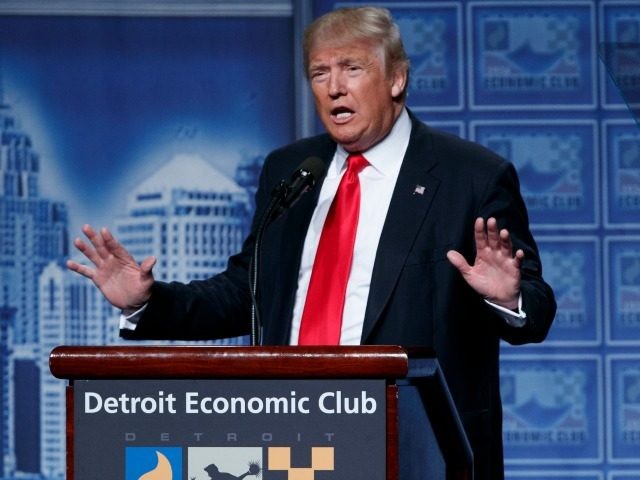Republican presidential nominee Donald Trump has presented an economic plan that would create a sustainable economic boom, beating Hillary Clinton’s economic plan by 75% when it comes to the federal budget deficit.
Despite the non-partisan Congressional Budget Office’s projections that U.S. Gross Domestic Product (GDP) will grow by 4.1 percent compounded over the next decade, the federal deficit will grow by $9.25 trillion over the period. Many economists question that high growth rate, given that U.S. GDP from 1948 until 2016 only grew at 3.21 percent annually, and the Obama years saw only 1.55 percent annual growth.
Hillary Clinton was seen as maintaining Barack Obama’s economic policies, but she was pushed substantially to the left by her primary challenger, Sen. Bernie Sanders (I-VT). Her current economic plan maintains all of the Obama spending. In addition, Clinton’s plan launches big infrastructure spending, provides mass college subsidies, nationalizes pre-school child care and spends more “sustainable energy” funds.
Clinton keeps Obama’s tax policies, but raises the top personal income tax bracket by 10 percent to 49.3 percent, and requires a minimum 30 percent tax on incomes over $1 million. The corporate tax rate is unchanged, but she surtaxes banks by $80 billion.
According to the independent Committee for a Responsible Federal Budget, Clinton’s budget plan would grow the U.S. deficit $9.9 trillion in the next decade. Under Clinton, the U.S. annual budget deficit would rise from 2.8 to 5 percent of GDP by 2026. Clinton’s new spending and tax disincentives add $650 billion to the CBO “baseline” deficit. As a result, the U.S. publicly held national debt increases from $14 to $23.9 trillion by 2026.
Donald Trump’s economic plan is the polar opposite of Clinton’s. Trump cuts personal tax brackets to 3 from 7; makes 25 percent the top personal tax rate; and exempts about 40 percent of Americans from paying any federal income tax.
In an assault on Wall Street, Trump eliminates the “carried interest exemption” that lets hedge fund traders convert their personal income to capital gains taxed at 15 percent; sets corporate rate at 15 percent; and taxes repatriated foreign profits at 10 percent.
Trump’s economic plan would be a financial challenge for U.S. multi-national corporations that have invested about $5 trillion offshore. From a steady annual foreign direct investment (FDI) level of about $50 billion a year when President Bill Clinton took office, his North American Free Trade Agreement (NAFTA) and China Most Favored Nation deal caused U.S. foreign direct investment to quadruple to $200 billion when Clinton left office in 2000. FDI dropped to about $150 billion a year during the Bush years, but FDI has more than doubled to $400 billion a year during President Obama’s Administration.
By offshoring the bulk of their manufacturing, customer service and a number of other operations, U.S. multinationals have been able to benefit from cheaper labor, avoid wildly expensive U.S. regulatory burden and massively export to the U.S. market.
One of the biggest reasons for American companies to offshore is to cut their tax burden from 35 percent in the U.S., to a maximum of 17 percent in China and as low as 2.5 percent in tax havens like Ireland. Nobel Prize-winning economist Joseph Stiglitz recently referred to this type of tax arbitrage by Apple Inc. and others as a “fraud.”
Economists refer to Hillary Clinton’s raising tax rates in the expectation of collecting more tax revenue as “pushing on a string.” The higher the cost of the U.S. tax and regulatory regime, the less Americans will invest at home and the greater the competitive advantage for multinationals’ producing offshore and exporting to the U.S.
In a 2008 debate with Hillary Clinton, Barack Obama acknowledged that historically raising tax rates means lower tax collection, and cutting rates increased tax collection. But Obama stated that he was more interested in “fairness.”
Most of the U.S. budget deficit is due to a crash in the “Labor Force Participation Rate” (LFPR), which peaked in the Bill Clinton administration at about 67 percent, and has crashed to less than 63 percent. With 159.3 million people currently in the civilian labor force, there is virtually no credible economist that believes Hillary Clinton’s plan to keep Obama’s economic policies, adding more taxes and regulation, will increase the LFPR.
Donald Trump’s economic policy focuses on increasing LFPR to make domestic businesses more competitive through lower taxes and freezing regulations. If the LFPR went back to 67 percent, there would be another 6.8 million labor participants, GDP would increase by $1.9 trillion, tax collection would increase by $400 billion, and the budget would be balanced, except for Social Security and Medicare.

COMMENTS
Please let us know if you're having issues with commenting.